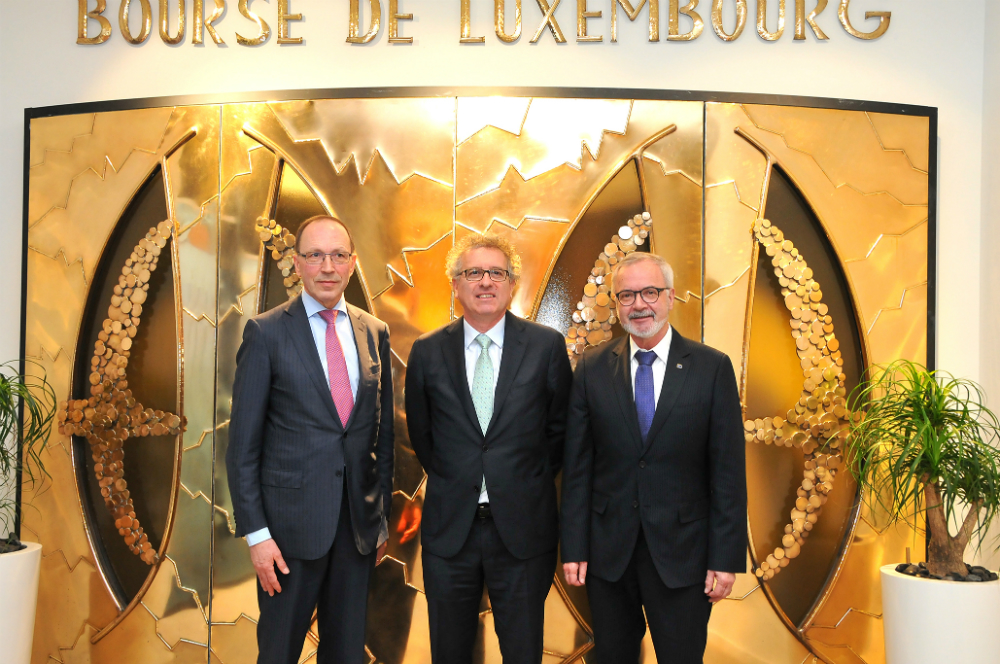How the EIB and the Luxembourg Stock Exchange raise the money that keeps climate change at bay
Climate action doesn’t come cheap. Developed countries are committed to mobilise USD 100 billion by 2020 to promote climate action in developing countries under a UN agreement. Then there’s the investment needed in developed nations to build innovative new technologies that generate clean power and protect the environment.
The Luxembourg Stock Exchange hit a landmark on the path to mobilising all that investment Friday with the listing of its one-hundredth Green Bond, a financial instrument for raising money that must be set to work for climate action or environmentally sustainable projects. The EUR 250 million new issue from the European Investment Bank increased the size of the EIB’s benchmark 2026 bond to EUR 1.5 billion, the largest Green Bond of that maturity.
“The greening of the bond market is vital for the future of climate finance, but it remains a challenge,” said EIB President Werner Hoyer at the launch of the new bond. “Capital markets and bond issues play a central role in raising capital globally and crowding-in public and private investors from all over the world.”
The new listing is a mark of the rapid growth of Green Bonds, which were developed and first issued by the EIB in 2007, also in a Luxembourg Stock Exchange listing. The EU bank has issued almost EUR 13 billion Green Bonds since then, making it the world’s biggest player. Other international financial institutions followed its lead, last year raising USD 40 billion in the Green Bond market—a vital source of financing for climate action.
How the EIB grows Green Bonds
The expansion of Green Bonds became yet more important after 196 international parties agreed on new measures to contain global warming at the Paris climate conference in December. “We’re actively supporting that goal at the forefront of financial innovation,” Hoyer said.
The EIB’s role in the growth of Green Bonds hasn’t been limited to rolling out maturities worth billions of euros—though it does have the biggest issues maturing in 2019 and 2023, at EUR 3 billion and EUR 1.5 billion respectively. In total the EIB has issued 59 Green Bonds in 11 currencies. But a big challenge for the Green Bond market has been the measurement and reporting of their impact. That’s where the EIB’s role has been key.
Different Green Bond issuers calculate different impact numbers for the same project. Investors have no certainty that the tonne of carbon dioxide they believed their money would keep from being emitted isn’t really a half tonne or even two tonnes.
But last year the EIB coordinated a group of 11 international financial institutions which released guidelines for the harmonized reporting of the impact of projects associated with Green Bonds. Thanks to this working group, a first authoritative market reference for Green Bond impact reporting harmonization was put in place. The guidelines aim to enhance transparency and accountability in the Green Bond market allowing it to mature and catalyse more funding to climate action.
Bond issues like the latest one in Luxembourg “ensure appropriate transparency,” said Pierre Gramegna, the country’s Finance Minister.

- Stock Exchange CEO Scharfe, Finance Minister Gramegna, and EIB President Hoyer
The next phase for Green Bonds
That’s an important factor in persuading investors to buy the Green Bonds the EIB lists on the Luxembourg Stock Exchange. They can be sure of the impact their investments will have on the climate and the environment. That certainty will be important in taking the Green Bond market further into the capital markets mainstream. Luxembourg Stock Exchange CEO Robert Scharfe recognised the expansion of the market at the launch of the new bond. “We commit to accompany green issuers into the next phase of the market,” he said.
The EIB brings climate into all areas of its operations. Wherever you look in the EUR 84.5 billion lending by the Bank last year alone, you find climate action. Some of it involved massive amounts of money, like the Green Bonds issues. Other projects were much smaller, like hydropower projects in the Ugandan hills or loans to solar power companies in Kenyan villages. But they’re all important, because they contribute international climate goals.
The Bank has increased its commitment to climate action. Its climate action loans in 2015 were a record EUR 20.6 billion (26.8% of all lending), in every one of the 28 EU member states, and in projects from Nicaragua to Nepal. The EIB also committed to increase climate action lending to 35% of its operations in developing countries by 2020.
The Bank’s Green Bonds on the Luxembourg Stock Exchange are another important step to maintaining these ambitious targets.
